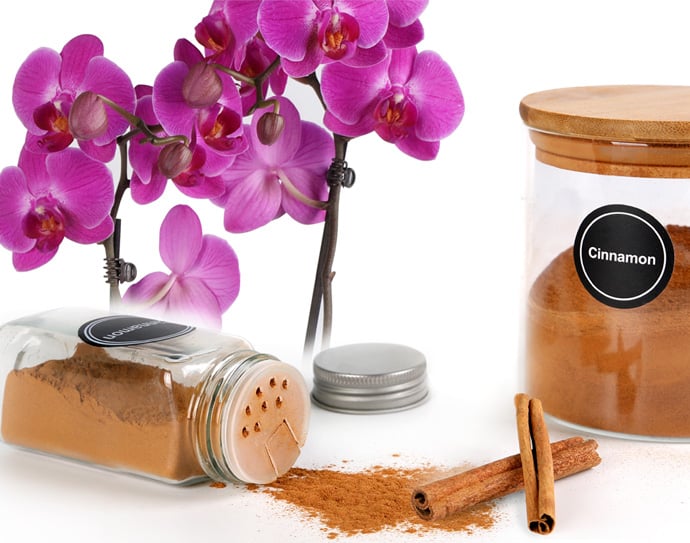
Cinnamon’s sweet, warm scent may evoke visions of freshly-baked rolls or apple cider, but did you know it has medicinal value for plants (and people)?
There are several trees in the genus Cinnamomum that are used to produce this spice, which is harvested by removing thin strips of inner bark and left out to dry. The practical and medicinal use of cinnamon predates the ancient Egyptian empire!
In today’s plant parenting world, cinnamon is commonly recommended for its use on plants because of its natural antimicrobial properties, so we decided to conduct our own experiment!
Cinnamon is a natural desiccant, meaning it quickly absorbs water. This makes cinnamon both safe for orchids when used properly, and dangerous when not.
Cinnamon can be applied to wounds on orchids to encourage the area to dry quickly while also preventing infection. When a damaged leaf is removed, for example, you can dab a bit of cinnamon on the cut to seal that part of the leaf off, creating a scab.
When cinnamon is applied to large areas of an orchid, however, it has a tendency to dry it up. This is especially true for orchid roots which need access to moisture in order to survive.
To test out this home remedy, we grabbed four petite orchids from the greenhouse and applied the cinnamon in various ways.
We treated the four orchids in our study the same in regards to watering and light. The difference is how and where we applied the cinnamon. We checked the orchids regularly for several weeks, noting any mold, yellowing leaves or bud loss.
Orchid 1: This orchid served as a control, so we didn’t apply cinnamon to this plant.
Orchid 2: We treated the second orchid with cinnamon that we sprinkled broadly around the leaves.
Orchid 3: We removed the third orchid from its pot so that we could apply the cinnamon broadly around the roots, separating the potting medium slightly to allow cinnamon to reach every root.
Orchid 4: Like the third orchid, we also removed the fourth orchid from its pot. This time, we applied cinnamon only to the ends of a few roots that had been trimmed off. This was the more directed approach, which mimics what might be done in cases when orchid roots were damaged due to watering issues. Additionally, we trimmed the end of one leaf and applied cinnamon to the wound directly.
The orchids whose roots were disturbed while the plant was in bloom suffered the most. Cinnamon has antibacterial and antifungal properties, but introducing it into a moist environment promotes mold growth. While its use in direct applications can work well if the cinnamon is allowed to dry and seal off a wound, introducing it into damp potting media was not beneficial.
Additionally, the broad use of cinnamon around the roots made it more difficult to determine root health - we could not see the root color, a major indicator of whether or not an orchid is ready for water.
Over-application of cinnamon to the roots did not yield any benefit. The hygroscopic properties (tendency to absorb water) of cinnamon both prevented the orchid roots from taking in a certain amount of hydration, but also created conditions that made it more difficult for the root system to breathe properly.
Since cinnamon is a desiccant: If you apply it to your orchid, it will dry out plant tissue. This is helpful when you are trying to seal off a wound, but when applied to healthy tissue —like sensitive roots — it can lead to problems.
Our recommendations? Use cinnamon sparingly in specific situations, and never in broad application. Instead, use it as a "Band-Aid" on orchid wounds.
It is best used at the tips of trimmed roots and at the edges of trimmed leaves. The cinnamon dries the wound out quickly and creates a barrier of dried tissue that prevents bacterial and fungal infection.
You can either dab dry cinnamon powder on the wound directly or create a paste from water and cinnamon for easier application. Remember to gently wipe away any extra cinnamon that ends up on areas of your orchid that do not need to be dried out!
For more orchid care tips, subscribe to our blog, follow us on Instagram and check out our resources page!

Copyright Just Add Ice® Orchids 2023